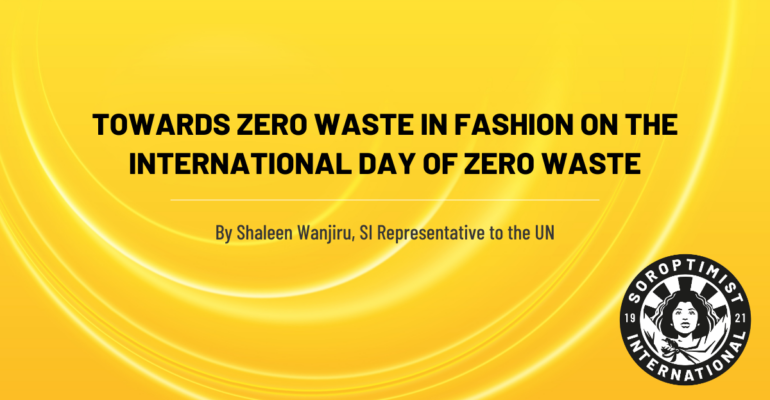Blog by Shaleen Wanjiru, SI Representative to UNEP in Nairobi.
Every year, the world produces a staggering 92 million tonnes of textile waste, with clothing production having doubled between 2000 and 2015. Yet, paradoxically, the lifespan of garments has shrunk by 36 per cent in the same period. This unsustainable trajectory has severe environmental, economic, and social repercussions—particularly in the Global South, where discarded clothing often ends up in landfills, waterways, and informal settlements.
On March 30, the International Day of Zero Waste, we spotlight the fashion and textile industry—one of the biggest contributors to global waste. The sector’s current linear business model of take-make-dispose fuels overproduction and overconsumption, exacerbating the triple planetary crisis of climate change, biodiversity loss, and pollution. Urgent action is needed to shift toward a circular economy, where resources are reused, repurposed, and recycled to minimise waste.
According to the United Nations Environment Programme (UNEP), 11 per cent of global plastic waste originates from clothing and textiles, yet only 8 per cent of textile fibres used in 2023 came from recycled sources. These numbers reflect an industry in dire need of transformation.
“Unsustainable fashion is aggravating the triple planetary crisis of climate change, nature, land and biodiversity loss, and pollution and waste. We need to focus on a circular economy approach that values sustainable production, reuse, and repair,”
— Inger Andersen, Executive Director of UNEP
Discarded textiles pose an alarming challenge, particularly in cities where waste management infrastructure is already stretched thin.
“The rising tide of waste is straining urban infrastructure, public health, and the environment—especially for 1.1 billion people in informal settlements and slums with limited waste collection and sanitation services,”
— Ana Cláudia Rossbach, Executive Director of UN-Habitat
Transitioning to a Zero-Waste Fashion Model
Moving toward a zero-waste fashion model requires coordinated efforts from governments, businesses, and consumers. Some key solutions include:
- Extended Producer Responsibility (EPR):
Policies requiring fashion brands to take accountability for their products throughout their lifecycle, including disposal and recycling. - Innovative Recycling & Upcycling:
New technologies, such as chemical recycling, can break down textiles into reusable fibres, reducing the need for virgin materials. - Sustainable Design & Slow Fashion:
Encouraging brands to create durable, high-quality garments and consumers to embrace mindful purchasing. - Consumer Awareness & Action:
Individuals can make a difference by choosing second-hand fashion, repairing clothes, and supporting brands that prioritise sustainability.
Groundbreaking Initiatives Recognised in Nairobi
This year, the UN Secretary-General’s Advisory Board on Zero Waste recognised three pioneering initiatives showcased in Nairobi:
- The United Wardrobe Project (Thailand):
A circular solution that has cut 98,000 kilograms of CO₂ emissions and conserved 33 million litres of water by repurposing textile waste. - LiiS.com (Norway):
A rental service that provides repairable garments to over 270,000 children, educating a new generation on sustainable fashion. - Closing The Loop Program (India):
An initiative redirecting post-consumer textiles from landfills to recycling markets.
These projects exemplify how innovation, policy, and consumer engagement can drive meaningful change.
The future of fashion is circular, but achieving zero waste requires all hands on deck. Governments must enact stricter regulations on textile waste, businesses must redesign their supply chains, and consumers must rethink their relationship with clothing.
This International Day of Zero Waste, let’s commit to transforming fashion from an industry of waste to one of sustainability.

